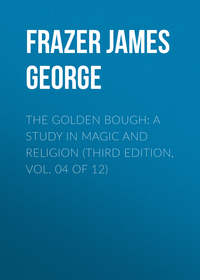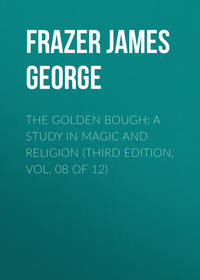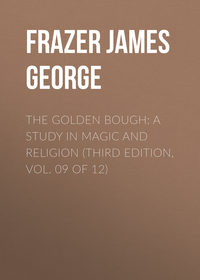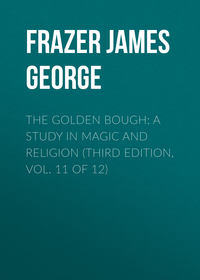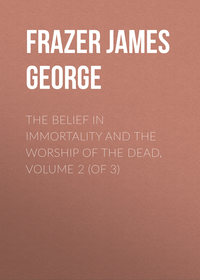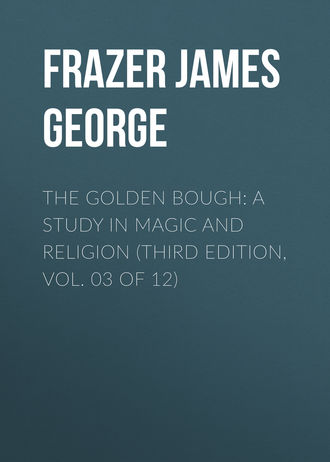 полная версия
полная версияThe Golden Bough: A Study in Magic and Religion (Third Edition, Vol. 03 of 12)
724
J. G. Campbell, Witchcraft and Second Sight in the Highlands and Islands of Scotland (Glasgow, 1902), pp. 262, 298, 299.
725
R. C. Maclagan, M.D., “Notes on Folklore Objects from Argyleshire,” Folk-lore, vi. (1895) p. 157; J. G. Campbell, Superstitions of the Highlands and Islands of Scotland (Glasgow, 1900), pp. 263-266. The shoulder-blades of sheep have been used in divination by many peoples, for example by the Corsicans, South Slavs, Tartars, Kirghiz, Calmucks, Chukchees, and Lolos, as well as by the Scotch. See J. Brand, Popular Antiquities, iii. 339 sq. (Bohn's ed.); Sir John Lubbock (Lord Avebury), Origin of Civilisation,4 pp. 237 sq.; Ch. Rogers, Social Life in Scotland, iii. 224; Camden, Britannia, translated by E. Gibson (London, 1695), col. 1046; M. MacPhail, “Traditions, Customs, and Superstitions of the Lewis,” Folk-lore, vi. (1895) p. 167; J. G. Dalyell, Darker Superstitions of Scotland, pp. 515 sqq.; F. Gregorovius, Corsica, (London, 1855), p. 187; F. S. Krauss, Volksglaube und religiöser Brauch der Südslaven, pp. 166-170; M. E. Durham, High Albania (London, 1909), pp. 104 sqq.; E. Doutté, Magie et religion dans l'Afrique du Nord (Algiers, 1908), p. 371; W. Radloff, Proben der Volksliteratur der türkischen Stämme Süd-Sibiriens, iii. 115, note 1, compare p. 132; J. Grimm, Deutsche Mythologie,4 ii. 932; W. W. Rockhill, The Land of the Lamas (London, 1891), pp. 176, 341-344; P. S. Pallas, Reise durch verschiedene Provinzen des russischen Reichs, i. 393; J. G. Georgi, Beschreibung aller Nationen des russischen Reichs, p. 223; T. de Pauly, Description ethnographique des peuples de la Russie, peuples de la Sibérie orientale (St. Petersburg, 1862), p. 7; Krahmer, “Der Anadyr-Bezirk nach A. W. Olssufjew,” Petermann's Mittheilungen, xlv. (1899) pp. 230 sq.; W. Bogoras, “The Chuckchee Religion,” Memoir of the American Museum of Natural History, The Jesup North Pacific Expedition, vol. vii. part ii. (Leyden and New York) pp. 487 sqq.; Crabouillet, “Les Lolos,” Missions Catholiques, v. (1873) p. 72; W. G. Aston, Shinto, p. 339; R. Andree, “Scapulimantia,” in Boas Anniversary Volume (New York, 1906), pp. 143-165.
726
C. F. Gordon Cumming, In the Hebrides, p. 226; E. J. Guthrie, Old Scottish Customs (London and Glasgow, 1885), p. 223.
727
1 Kings vi. 7; Exodus xx. 25.
728
Dionysius Halicarnasensis, Antiquit. Roman. iii. 45, v. 24; Plutarch, Numa, 9; Pliny, Nat. Hist. xxxvi. 100.
729
Acta Fratrum Arvalium, ed. G. Henzen, p. 132; Corpus Inscriptionum Latinarum, i. No. 603.
730
Pliny, Nat. Hist. xxxvi. 100.
731
Indian Antiquary, x. (1881) p. 364.
732
Prof. W. Ridgeway ingeniously suggests that the magical virtue of iron may be based on an observation of its magnetic power, which would lead savages to imagine that it was possessed of a spirit. See Report of the British Association for 1903, p. 816.
733
Frank Hatton, North Borneo (1886), p. 233.
734
A. E. Pratt, “Two Journeys to Ta-tsien-lu on the eastern Borders of Tibet,” Proceedings of the R. Geographical Society, xiii. (1891) p. 341.
735
W. Svoboda, “Die Bewohner des Nikobaren-Archipels,” Internationales Archiv für Ethnographie, vi. (1893) p. 13.
736
The Captivity of Hans Stade of Hesse, in a. d. 1547-1555, translated by A. Tootal (London, 1874), pp. 85 sq.
737
E. H. Fraser, “The Fish-skin Tartars,” Journal of the China Branch of the R. Asiatic Society for the Year 1891-92, N.S. xxvi. p. 15.
738
Fr. Kreutzwald und H. Neus, Mythische und magische Lieder der Ehsten (St. Petersburg, 1854), p. 113.
739
Alexand. Guagninus, “De ducatu Samogitiae,” in Respublica sive status regni Poloniae, Lituaniae, Prussiae, Livoniae, etc. (Elzevir, 1627) p. 276; Johan. Lasicius, “De diis Samogitarum caeterorumque Sarmatum,” in Respublica, etc. (ut supra), p. 294 (p. 84, ed. W. Mannhardt, in Magazin herausgegeben von der Lettisch – Literärischen Gesellschaft, vol. xiv.).
740
L. von Ende, “Die Baduwis von Java,” Mittheilungen der anthropologischen Gesellschaft in Wien, xix. (1889) p. 10.
741
J. G. Campbell, Superstitions of the Highlands and Islands of Scotland (Glasgow, 1900), pp. 46 sq.
742
E. J. Guthrie, Old Scottish Customs, p. 149; Ch. Rogers, Social Life in Scotland (Edinburgh, 1884-1886), iii. 218.
743
J. Macdonald, Religion and Myth, p. 91.
744
W. Gregor, Folk-lore of the North-East of Scotland (London, 1881), p. 201. The fishermen think that if the word “pig,” “sow,” or “swine” be uttered while the lines are being baited, the line will certainly be lost.
745
A. Leared, Morocco and the Moors (London, 1876), p. 273.
746
Wickremasinghe, in Am Urquell, v. (1894) p. 7.
747
G. F. D'Penha, “Superstitions and Customs in Salsette,” Indian Antiquary, xxviii. (1899) p. 114.
748
W. Crooke, Tribes and Castes of the North-Western Provinces and Oudh, iii. 431.
749
F. Jagor, “Bericht über verschiedene Volksstämme in Vorderindien,” Zeitschrift für Ethnologie, xxvi. (1894) p. 70.
750
E. Thurston, Ethnographic Notes in Southern India (Madras, 1906), p. 341.
751
E. M. Gordon, Indian Folk Tales (London, 1908), p. 31.
752
L. R. P. Cadière, “Coutumes populaires de la vallée du Nguôn-So'n,” Bulletin de l'École Française d'Extrême-Orient, ii. (1902) pp. 354 sq.
753
Baudin, “Le Fétichisme,” Missions Catholiques, xvi. (1884) p. 249; A. B. Ellis, The Yoruba-speaking Peoples of the Slave Coast, p. 113.
754
Il Fetha Nagast o legislazione dei re, codice ecclesiastico e civile di Abissinia, tradotto e annotato da Ignazio Guidi (Rome, 1899), p. 140.
755
The reader may observe how closely the taboos laid upon mourners resemble those laid upon kings. From what has gone before, the reason of the resemblance is obvious.
756
Panjab Notes and Queries, iii. p. 61, § 282.
757
G. F. D'Penha, “Superstitions and Customs in Salsette,” Indian Antiquary, xxviii. (1899) p. 115.
758
W. Gregor, Folk-lore of the North-East of Scotland, p. 206.
759
This is expressly said in Panjab Notes and Queries, iii. p. 202, § 846. On iron as a protective charm see also F. Liebrecht, Gervasius von Tilbury, pp. 99 sqq.; id., Zur Volkskunde, p. 311; L. Strackerjan, Aberglaube und Sagen aus dem Herzogthum Oldenburg, i. pp. 354 sq. § 233; A. Wuttke, Der deutsche Volksaberglaube,2 § 414 sq.; E. B. Tylor, Primitive Culture,2 i. 140; W. Mannhardt, Baumkultus, p. 132 note. Many peoples, especially in Africa, regard the smith's craft with awe or fear as something uncanny and savouring of magic. Hence smiths are sometimes held in high honour, sometimes looked down upon with great contempt. These feelings probably spring in large measure from the superstitions which cluster round iron. See R. Andree, Ethnographische Parallelen und Vergleiche, pp. 153-159; G. McCall Theal, Records of South-Eastern Africa, vii. 447; O. Lenz, Skizzen aus West-Afrika (Berlin, 1878), p. 184; A. Bastian, Die deutsche Expedition an der Loango-Küste, ii. 217; M. Merkel, Die Masai (Berlin, 1904), pp. 110 sq.; A. C. Hollis, The Masai (Oxford, 1905), pp. 330 sq.; id., The Nandi (Oxford, 1909), pp. 36 sq.; J. Spieth, Die Ewe-Stämme (Berlin, 1906), p. 776; E. Doutté, Magie et religion dans l'Afrique du Nord, pp. 40 sqq.; Ph. Paulitschke, Ethnographie Nordost-Afrikas, die geistige Cultur der Danâkil, Galla und Somâl (Berlin, 1896), p. 30; id., Ethnographie Nordost-Afrikas, die materielle Cultur der Danâkil, Galla und Somâl (Berlin, 1893), p. 202; Th. Levebvre, Voyage en Abyssinie, i. p. lxi.; A. Cecchi, Da Zeila alle frontiere del Caffa, i. (Rome, 1886) p. 45; M. Parkyns, Life in Abyssinia2 (London, 1868), pp. 300 sq.; J. T. Bent, Sacred City of the Ethiopians (London, 1893), p. 212; G. Rohlf, “Reise durch Nord-Afrika,” Petermann's Mittheilungen, Ergänzungsheft, No. 25 (Gotha, 1868), pp. 30, 54; G. Nachtigal, “Die Tibbu,” Zeitschrift für Erdkunde zu Berlin, v. (1870) pp. 312 sq.; id., Sahara und Sudan, i. 443 sq., ii. 145, 178, 371, iii. 189, 234 sq. The Kayans of Borneo think that a smith is inspired by a special spirit, the smith's spirit, and that without this inspiration he could do no good work. See A. W. Nieuwenhuis, Quer durch Borneo, ii. 198.
760
A. Bastian, Die Völker des östlichen Asien, i. (Leipsic, 1866) p. 136.
761
E. W. Nelson, “The Eskimo about Bering Strait,” Eighteenth Annual Report of the Bureau of American Ethnology, part i. (Washington, 1899) p. 312. Compare ibid. pp. 315, 364; W. H. Dall, Alaska and its Resources, p. 146; id., in American Naturalist, xii. 7; id., in The Yukon Territory (London, 1898), p. 146.
762
See above, p. 205.
763
A. Woldt, Captain Jacobsen's Reise an der Nordwestküste Americas 1881-1883 (Leipsic, 1884), p. 243.
764
W. Schmidt, Das Jahr und seine Tage in Meinung und Brauch der Romänen Siebenbürgens (Hermannstadt, 1866), p. 40; E. Gerard, The Land beyond the Forest, i. 312.
765
J. H. Gray, China (London, 1878), i. 288.
766
Jo. Meletius (Maeletius, Menecius), “De religione et sacrificiis veterum Borussorum,” in De Russorum Muscovitarum et Tartarorum religione, sacrificiis, nuptiarum, funerum ritu (Spires, 1582), p. 263; id., reprinted in Scriptores rerum Livonicarum, vol. ii. (Riga and Leipsic, 1848) pp. 391 sq., and in Mitteilungen der Litterarischen Gesellschaft Masovia, viii. (Lötzen, 1902) pp. 194 sq. Compare Chr. Hartknoch, Alt und neues Preussen (Frankfort and Leipsic, 1684), pp. 187 sq.
767
B. F. Matthes, Bijdragen tot de Ethnologie van Zuid-Celebes, p. 136.
768
Tettau und Temme, Die Volkssagen Ostpreussens, Litthauens und Westpreussens, p. 285; J. Grimm, Deutsche Mythologie,4 iii. 454, compare pp. 441, 469; J. V. Grohmann, Aberglauben und Gebräuche aus Böhmen und Mähren, p. 198, § 1387.
769
Franz Vormann, “Zur Psychologie, Soziologie und Geschichte der Monumbo-Papua, Deutsch-Neuginea,” Anthropos, v. (1910) p. 410.
770
A. W. Nieuwenhuis, In Centraal Borneo (Leyden, 1900), i. 61; id., Quer durch Borneo, i. 69.
771
Fr. Stuhlmann, Mit Emin Pascha ins Herz von Afrika (Berlin, 1894), p. 184.
772
J. J. M. de Groot, The Religious System of China, iii. 1045 (Leyden, 1897).
773
Plutarch, Quaest. Rom. 110; Aulus Gellius, x. 15. 12. See above, p. 13.
774
Grihya-Sutras, translated by H. Oldenberg, part i. pp. 81, 141 (Sacred Books of the East, vol. xxix.).
775
J. Roscoe, “Further Notes on the Manners and Customs of the Baganda,” Journal of the Anthropological Institute, xxxii. (1902) p. 53.
776
J. Kubary, Die socialen Einrichtungen der Pelauer (Berlin, 1885), pp. 126 sq.
777
F. J. Wiedemann, Aus dem inneren und äussern Leben der Ehsten (St. Petersburg, 1876), pp. 448, 478.
778
James Adair, History of the American Indians (London, 1775), pp. 134, 117. The Indians described by Adair are the Creek, Cherokee, and other tribes in the south-east of the United States.
779
A. G. Morice, “The Western Dénés, their Manners and Customs,” Proceedings of the Canadian Institute, Third Series, vii. (1888-89) p. 164.
780
E. Petitot, Monographie des Dènè-Dindjié (Paris, 1876), p. 76.
781
Schlömann, “Die Malepa in Transvaal,” Verhandlungen der Berliner Gesellschaft für Anthropologie, Ethnologie und Urgeschichte, 1894, p. (67).
782
Leviticus xvii. 10-14. The Hebrew word (נפש) translated “life” in the English version of verse 11 means also “soul” (marginal note in the Revised Version). Compare Deuteronomy xii. 23-25.
783
Servius on Virgil, Aen. v. 79; compare id. on Aen. iii. 67.
784
J. Wellhausen, Reste arabischen Heidentumes (Berlin, 1887), p. 217.
785
J. J. M. de Groot, Religious System of China, iv. 80-82.
786
A. Goudswaard, De Papoewa's van de Geelvinksbaai (Schiedam, 1863), p. 77.
787
Hamilton's “Account of the East Indies,” in Pinkerton's Voyages and Travels, viii. 469. Compare W. Robertson Smith, Religion of the Semites,2 i. 369, note 1.
788
De la Loubere, Du royaume de Siam (Amsterdam, 1691), i. 317.
789
Pallegoix, Description du royaume Thai ou Siam, i. 271, 365 sq.
790
Marco Polo, translated by Col. H. Yule (Second Edition, 1875), i. 335.
791
Col. H. Yule on Marco Polo, l. c.
792
A. Fytche, Burma, Past and Present (London, 1878), i. 217 note. Compare Indian Antiquary, xxix. (1900) p. 199.
793
Indian Antiquary, xx. (1891) p. 49.
794
Baron's “Description of the Kingdom of Tonqueen,” in Pinkerton's Voyages and Travels, ix. 691.
795
T. E. Bowdich, Mission from Cape Coast Castle to Ashantee (London, 1873), p. 207.
796
A. B. Ellis, Ewe-speaking Peoples of the Slave Coast, p. 224, compare p. 89.
797
O. Dapper, Description de l'Afrique (Amsterdam, 1686), p. 313.
798
J. Sibree, Madagascar and its People, p. 430.
799
J. Roscoe, “Further Notes on the Manners and Customs of the Baganda,” Journal of the Anthropological Institute, xxxii. (1902) p. 50.
800
C. T. Wilson and R. W. Felkin, Uganda and the Egyptian Soudan (London, 1882), i. 200.
801
J. Roscoe, op. cit. p. 67. There is an Arab legend of a king who was slain by opening the veins of his arms and letting the blood drain into a bowl; not a drop might fall on the ground, otherwise there would be blood revenge for it. Robertson Smith conjectured that the legend was based on an old form of sacrifice regularly applied to captive chiefs (Religion of the Semites,2 p. 369 note, compare p. 418 note).
802
Rev. E. Gottschling, “The Bawenda,” Journal of the Anthropological Institute, xxxv. (1905) p. 366.
803
Marco Polo, i. 399, Yule's translation, Second Edition.
804
Sir Walter Scott, note 2 to Peveril of the Peak, ch. v.
805
Charlotte Latham, “Some West Sussex Superstitions,” Folk-lore Record, i. (1878) p. 17.
806
Native Tribes of South Australia, p. 230; E. J. Eyre, Journals of Expeditions of Discovery into Central Australia, ii. 335; R. Brough Smyth, Aborigines of Victoria, i. 75 note.
807
D. Collins, Account of the English Colony of New South Wales (London, 1798), p. 580.
808
Native Tribes of South Australia, pp. 224 sq.; G. F. Angas, Savage Life and Scenes in Australia and New Zealand (London, 1847), i. 110 sq.
809
The Magic Art and the Evolution of Kings, vol. i. p. 256.
810
Edmund Spenser, View of the State of Ireland, p. 101 (reprinted in H. Morley's Ireland under Elizabeth and James the First, London, 1890).
811
“Futuna, or Horne Island and its People,” Journal of the Polynesian Society, vol. i. No. 1 (April 1892), p. 43.
812
Max Radiguet, Les Derniers Sauvages (Paris, 1882), p. 175.
813
B. F. Matthes, Bijdragen tot de Ethnologie van Zuid-Celebes, p. 53.
814
Fr. Stuhlmann, Mit Emin Pascha ins Herz von Afrika, p. 795.
815
Miss Mary H. Kingsley, Travels in West Africa, pp. 440, 447.
816
A. Kropf, “Die religiösen Anschauungen der Kaffern,” Verhandlungen der Berliner Gesellschaft für Anthropologie, Ethnologie und Urgeschichte, 1888, p. (46).
817
R. H. Nassau, Fetichism in West Africa (London, 1904), p. 83.
818
Le R. P. Guis, “Les Nepu ou Sorciers,” Missions Catholiques, xxxvi. (1904) p. 370. See also The Magic Art and the Evolution of Kings, vol. i. p. 205.
819
A. van Gennep, Tabou et totémisme à Madagascar, p. 338, quoting J. Sibree, “Remarkable Ceremonial at the Decease and Burial of a Betsileo Prince,” Antananarivo Annual, No. xxii. (1898) pp. 195 sq.
820
Brun-Rollet, Le Nil Blanc et le Soudan (Paris, 1855), pp. 239 sq.
821
Dudley Kidd, The Essential Kafir, p. 169.
822
Lieut. Emery, in Journal of the R. Geographical Society, iii. 282.
823
Ch. Andersson, Lake Ngami (London, 1856), p. 224.
824
Ch. New, Life, Wanderings, and Labours in Eastern Africa, p. 124; Francis Galton, “Domestication of Animals,” Transactions of the Ethnological Society of London, N.S., iii. (1865) p. 135. On the original sanctity of domestic animals see, above all, W. Robertson Smith, The Religion of the Semites,2 pp. 280 sqq., 295 sqq.
825
J. Spieth, Die Ewe-Stämme, p. 796.
826
L. Linton Palmer, “A Visit to Easter Island,” Journal of the R. Geographical Society, xl. (1870) p. 171.
827
R. H. Codrington, The Melanesians, p. 129.
828
Strabo, xv. 1. 54, p. 710.
829
R. Taylor, Te Ika a Maui, or New Zealand and its Inhabitants,2 pp. 194 sq.
830
Plutarch, Quaest. Rom. 112; Aulus Gellius, x. 15. 13. See above, p. 14.
831
The Magic Art and the Evolution of Kings, vol. ii. pp. 18, 20.
832
Compare W. Robertson Smith, Religion of the Semites,2 p. 230.
833
“Dialis cotidie feriatus est,” Aulus Gellius, x. 15. 16.
834
Plutarch, Isis et Osiris, 6. A myth apparently akin to this has been preserved in some native Egyptian writings. See Ad. Erman, Ägypten und ägyptisches Leben im Altertum, p. 364. Wine might not be taken into the temple at Heliopolis (Plutarch, Isis et Osiris, 6). It was apparently forbidden to enter the temple at Delos after drinking wine (Dittenberger, Sylloge Inscriptionum Graecarum,2 No. 564). When wine was offered to the Good Goddess at Rome it was not called wine but milk (Macrobius, Saturn, i. 12. 5; Plutarch, Quaest. Rom. 20). It was a rule of Roman religion that wine might not be poured out in libations to the gods which had been made either from grapes trodden with bleeding feet or from the clusters of a vine beside which a human body had hung in a noose (Pliny, Nat. Hist. xiv. 119). This rule shews that wine was supposed to be defiled by blood or death.
835
Bernardino de Sahagun, Histoire générale des choses de la Nouvelle-Espagne, traduite par Jourdanet et Siméon (Paris, 1880), pp. 46 sq. The native Mexican wine (pulque) is made from the sap of the great American aloe. See the note of the French translators of Sahagun, op. cit. pp. 858 sqq.; E. J. Payne, History of the New World called America, i. 374 sqq. The Chiquites Indians of Paraguay believed that the spirit of chica, or beer made from maize, could punish with sickness the person who was so irreverent or careless as to upset a vessel of the liquor. See Charlevoix, Histoire du Paraguay (Paris, 1756), ii. 234.
836
See The Magic Art and the Evolution of Kings, vol. i. pp. 381 sqq.
837
Op. cit. vol. i. pp. 384 sq.
838
E. M. Curr, The Australian Race (Melbourne and London, 1887), iii. 179.
839
H. B. Guppy, The Solomon Islands and their Natives (London, 1887), p. 41.
840
E. B. Cross, “On the Karens,” Journal of the American Oriental Society, iv. (1854) p. 312.
841
A. Bastian, Die Völker des östlichen Asien, iii. 230.
842




